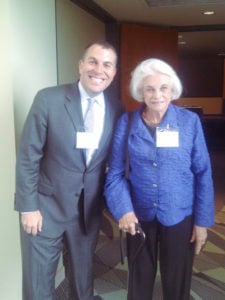Write Like Justice O'Connor: The Art of the Confident Concession
 “Being a member of the Court is a little like walking through fresh concrete,” said Justice O’Connor. “We look back and see our footprints in those opinions that we’ve written and they tend to harden after us.” From a legal-writing perspective, how might you follow in her footsteps?
“Being a member of the Court is a little like walking through fresh concrete,” said Justice O’Connor. “We look back and see our footprints in those opinions that we’ve written and they tend to harden after us.” From a legal-writing perspective, how might you follow in her footsteps?
Revered for her sensible pragmatism on doctrinal matters, Justice O’Connor was also a cautious stylist. Her 676 opinions display few of Justice Scalia’s barbs and little of Justice Kagan’s wit. Yet she was unusually adept at creating order out of chaos and at conjuring fairness even when her conclusions proved controversial.
The Pragmatically Persuasive Pivot
Does biography matter? Perhaps so. For a skilled legislator and majority leader like O’Connor, persuading often means conceding just enough to win over colleagues and the public. In her later work as Justice O’Connor, she showed us how the same is true of written advocacy. Rare is the dispute, in fact, in which both the facts and the law favor one position alone. For Justice O’Connor, embracing counterarguments and counterpoints confidently—but then pivoting fast to what matters even more—hardened into a recipe for her doctrinal wins as much as her earlier political victories.
It’s no surprise in that regard that she favored sentences starting with “Although.” I’ve long pointed out that such sentences provide a two-for-one: By conceding a point in an “Although” clause, you earn credit for candor and reasonableness while shifting the reader’s gaze to the main clause that follows. Take these two early examples—one factual and the other legal—from Justice O’Connor’s majority opinion in Mississippi University for Women v. Hogan just a year after she joined the Court:
Although Hogan could have attended classes and received credit in one of Mississippi’s state-supported coeducational nursing programs, none of which was located in Columbus, he could attend only by driving a considerable distance from his home.
Although the test for determining the validity of a gender-based classification is straightforward, it must be applied free of fixed notions concerning the roles and abilities of males and females.
Later, in Maryland v. Craig, she made a hybrid law-and-fact concession: Allowing a criminal defendant to confront child witnesses face-to-face had subtle advantages. Even so, she insisted, those advantages cannot outweigh the harm that putting a child live on the stand could cause:
Although we are mindful of the many subtle effects face-to-face confrontation may have on an adversary criminal proceeding, the presence of these other elements of confrontation—oath, cross-examination, and observation of the witness’ demeanor—adequately ensures that the testimony is both reliable and subject to rigorous adversarial testing in a manner functionally equivalent to that accorded live, in-person testimony.
An “Although” structure is just one option, of course. Here is another: Make quick work of your concession in a neutral-sounding sentence, and then hit the reader with “But” or “Yet.” It was through that structure that Justice O’Connor explained her views about imposing the death penalty on adolescent defendants:
Adolescents as a class are undoubtedly less mature, and therefore less culpable for their misconduct, than adults. But the Court has adduced no evidence impeaching the seemingly reasonable conclusion reached by many state legislatures: that at least some 17–year–old murderers are sufficiently mature to deserve the death penalty in an appropriate case.
The Slow Savor
In other instances, you are in no rush to get the concession out of the way. You might even want to save it. If so, you could follow Justice O’Connor’s “It is true that” pattern—just before conceding a point that costs you little. You can see how she did so in her concurrence in McCreary County v. ACLU, one of a pair of 2005 Ten Commandments cases:
It is true that many Americans find the Commandments in accord with their personal beliefs. But we do not count heads before enforcing the First Amendment.
It is true that the Framers lived at a time when our national religious diversity was neither as robust nor as well recognized as it is now. They may not have foreseen the variety of religions for which this Nation would eventually provide a home. They surely could not have predicted new religions, some of them born in this country. But they did know that line-drawing between religions is an enterprise that, once begun, has no logical stopping point.
Yet another type of confident concession can convey a whiff of exasperation—as if any naysayers are making a debater’s point at best. You can detect such a tone in Justice O’Connor 2003 Lawrence v. Texas concurrence:
A State can of course assign certain consequences to a violation of its criminal law. But the State cannot single out one identifiable class of citizens for punishment that does not apply to everyone else, with moral disapproval as the only asserted state interest for the law.
On the other hand, it also costs a persuasive writer nothing to concede a point about a world that simply does not exist. You can see how Justice O’Connor exploited that technique in her 1984 dissent in New York v. Quarles:
Were the Court writing from a clean slate, I could agree with its holding. But Miranda is now the law and, in my view, the Court has not provided sufficient justification for departing from it or for blurring its now clear strictures.
And again two decades later in her dissent in Gonzales v. Raich:
If I were a California citizen, I would not have voted for the medical marijuana ballot initiative; if I were a California legislator I would not have supported the Compassionate Use Act. But whatever the wisdom of California’s experiment with medical marijuana, the federalism principles that have driven our Commerce Clause cases require that room for experiment be protected in this case.
Counterpoint Checkmate
Finally, a confident concession can morph into a unifying character that makes an entire passage cohere. An excellent example is in Justice O’Connor’s concurrence in Lynch v. Donnelly, the case in which she put her pivotal gloss on the now-defunct Lemon test. Here, she concedes—and then returns to—a point about how political divisiveness intersects with the Establishment Clause. But beyond that point she refuses to budge:
Although several of our cases have discussed political divisiveness under the entanglement prong of Lemon, . . . we have never relied on divisiveness as an independent ground for holding a government practice unconstitutional. Guessing the potential for political divisiveness inherent in a government practice is simply too speculative an enterprise, in part because the existence of the litigation, as this case illustrates, itself may affect the political response to the government practice. Political divisiveness is admittedly an evil addressed by the Establishment Clause. Its existence may be evidence that institutional entanglement is excessive or that a government practice is perceived as an endorsement of religion. But the constitutional inquiry should focus ultimately on the character of the government activity that might cause such divisiveness, not on the divisiveness itself. The entanglement prong of the Lemon test is properly limited to institutional entanglement.
In an era of increasingly strident prose—including at our nation’s highest courts—concessions can seem quaint, if not naive. But if you’re trying to change minds, acknowledging counterarguments and trusting the reader’s intelligence still pack a greater punch than do rants that win applause only from the already converted. Justice O’Connor bequeathed a path to that very form of persuasive advocacy. As she put it in another context in McCreary County v. ACLU, “Why would we trade a system that has served us so well for one that has served others so poorly?”
 By
By






